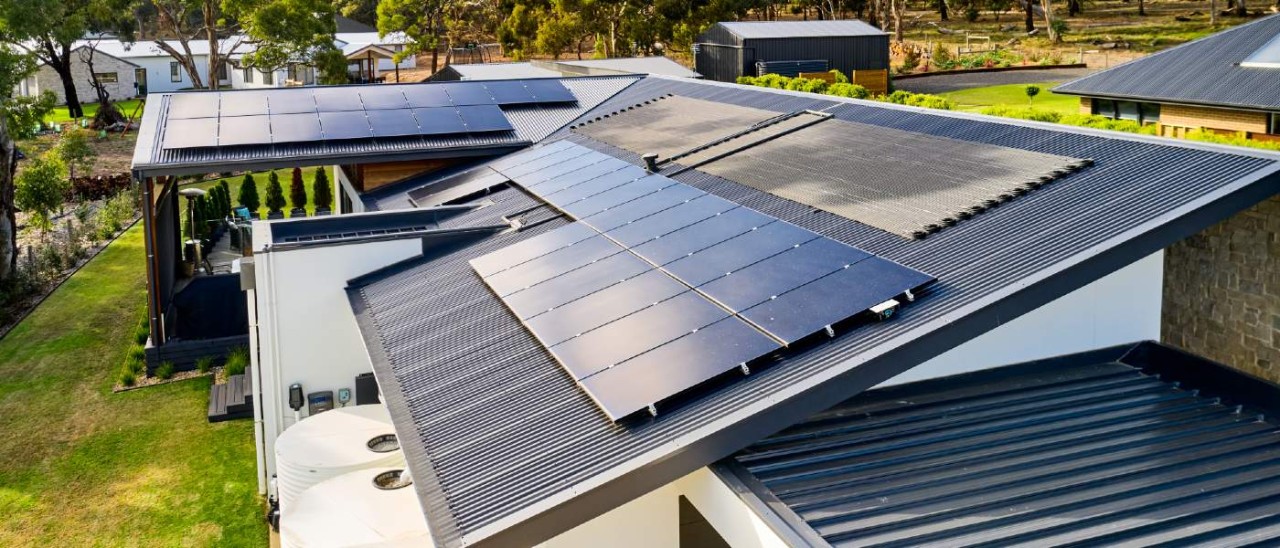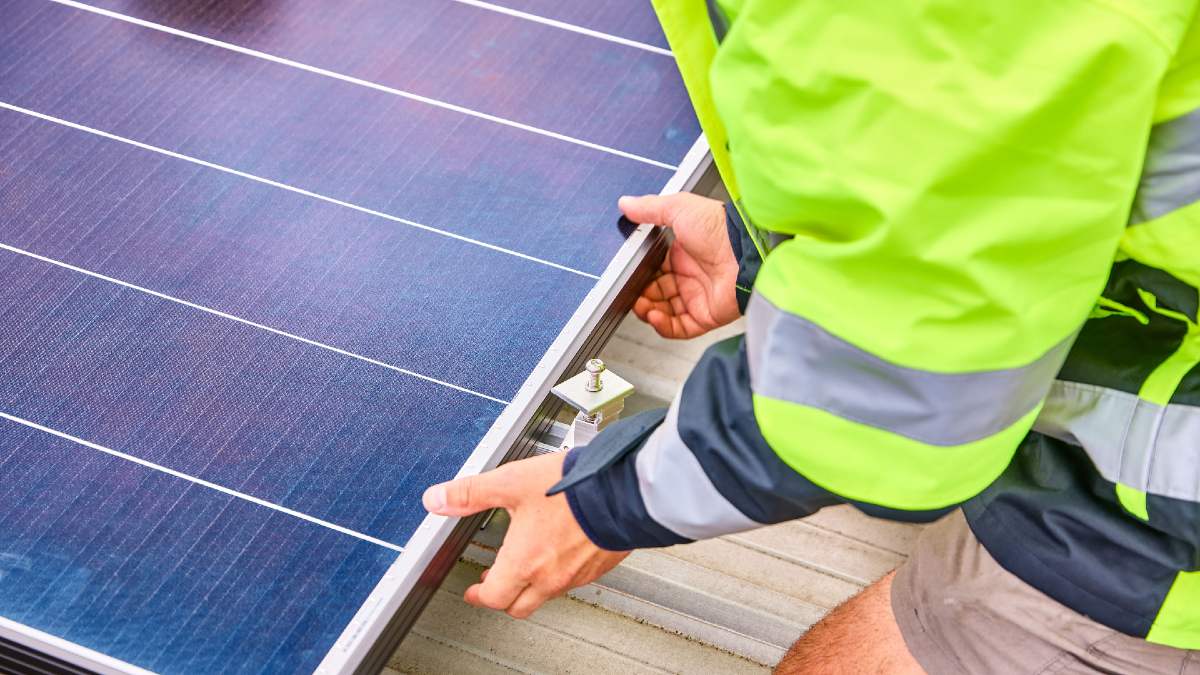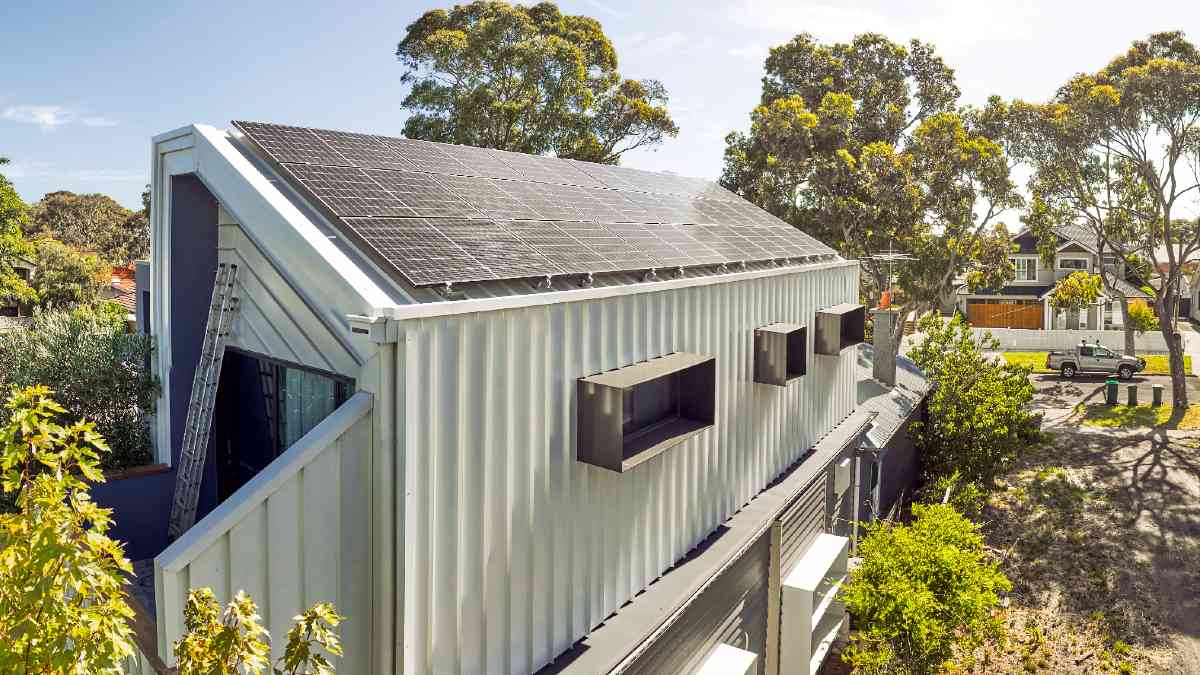Interested in solar energy but worried about the upkeep? Check out our handy FAQ guide on how to maintain your solar system.
How does home solar power work? Solar panels & batteries explained

Thinking of installing a rooftop solar system but have no idea where to start? You’re not alone. Here are the answers to your most frequently asked solar questions.
Australia has the highest uptake of household solar in the world, according to the Australian Government's Clean Energy Regulator. More than four million rooftops across Australia have solar installed - that's one in three Australian homes - according to Clean Energy Council, which also reports that rooftop solar now accounts for 11.2 per cent of Australia's electricity supply.
It's no wonder, then, that many more Australians are considering installing household solar systems to increase electrification in their homes, covering everything from home appliances to cooling, heating, and hot water. But how exactly does solar power work in a residential setting? What do solar panels, batteries and grids do? And how much does it all cost? Here's a comprehensive breakdown of how home solar systems function, and what homeowners in Victoria need to know before making the switch.
Jump to
Solar power explained
What is solar power?
Solar power is electricity that's generated by converting sunlight into energy.
This is typically done using photovoltaic (PV) cells: the kind found in most rooftop solar panels. When sunlight hits a PV cell, it knocks electrons loose from their atoms and generates a flow of electricity. This flow, called direct current (DC), is then converted into alternating current (AC), which is the type of electricity used in Australian homes. That electricity can power your residence and/or be stored in a solar battery for later use.
How does a home solar system work?
At its core, a home solar system consists of solar panels, an inverter, optional battery storage, and a connection to the electricity grid.
When the sun is shining, the solar panels capture sunlight and generate DC electricity. The inverter converts this DC electricity into AC electricity for use in the home. Power is then directed to your home's systems and appliances.
If you're producing more energy than you use, it can be stored in a battery or exported to the grid. At night or during low-sunlight hours, you either draw electricity from your battery (if you have one) or from the grid.
What happens to solar systems when there's no sun?
Solar panels don't stop working entirely on cloudy days, but they do operate at reduced efficiency. At night, they won't produce any electricity at all.
That's why most home solar systems remain connected to the grid, and why many households are investing in battery storage for greater energy independence.
Why should you get solar power?
Solar power is a renewable energy source, meaning it's naturally replenished and doesn't deplete over time. Unlike fossil fuels, solar power doesn't produce harmful greenhouse gas emissions during operation, making it a more environmentally-friendly way to reduce your carbon footprint.
Using solar energy in your home or business can also significantly reduce energy bill costs. That's because you can generate and use your own electricity when the sun is shining, rather than buying electricity from an energy retailer.
If you have a solar battery, you can store the excess solar power generated during the day to use overnight, thus significantly reducing (or in some cases even eliminating) your need to buy electricity from your energy retailer.
Can solar energy power everything in my home?
In theory, a large solar system could produce enough energy to power your entire household consumption. If you want to run your house entirely on solar power, you'll need a large enough solar system to exceed your household usage, plus a solar battery to store excess solar power generated during the day for use when the sun goes down.
If you don't have a solar battery, another option to maximise your use of solar power is getting a heat pump hot water system. By running a heat pump hot water system during daylight hours, you can use your solar power to heat the water and store it for use whenever you're ready, effectively storing the solar energy as hot water. This can be a great way to maximise solar savings and reduce your household's energy costs.
At night, if you don't have solar power stored in a battery, your house simply draws power from the grid as it did before the solar system was installed. This happens automatically, as the solar system is wired in parallel with your main supply.
What happens to the solar energy I don’t use?
Excess solar power you're not using when your panels are generating electricity can be stored in a battery for use later on if you have one.
If not, it will flow automatically back into the electricity grid for other homes and businesses to use, and you’ll be paid a feed-in tariff from your energy retailer for that exported electricity. These feed-in tarrifs have reduced significantly as solar power has become cheaper.
Who can get solar panels?
All Victorian property owners can get solar panels, provided their residence has the ability for solar installation. You can also get a tailored quote to talk about the best sustainable energy options for your household or workplace.

RACV Solar can install a range of solar products for your household. Image: Matt Harvey
Solar panels, inverters,batteries and the grid: what are they?
Solar panels
Solar panels are the most visible part of a home solar system. Made up of photovoltaic (PV) cells, solar panels are typically installed on your roof in a spot that gets maximum sunlight throughout the day. In Australia, this is usually facing north.
Each solar panel is made up of many individual solar cells, which in turn are made from thin wafers of silicon sandwiched together. Sunlight hitting these silicon cells provides the energy for electrons to move between the silicon layers. This flow of electrons is the electricity that solar panels produce.
There are three main types of solar panels:
- Monocrystalline panels - the most efficient and longest lasting, but also the most expensive
- Polycrystalline panels- slightly less efficient, but more affordable and popular for budget-conscious households
- Thin-film panels - lightweight and flexible, but generally less efficient and not as common in residential settings.
Panels come in various wattages and efficiencies. Most Australian homes install systems ranging from 3kW to 10kW, depending on their energy needs.
Solar inverters
An inverter plays a critical role by converting DC electricity into usable AC electricity. Without an inverter, the power generated by your solar panels couldn't be used in the home or exported to the grid.
There are two main types of inverters:
- String inverters - connect a series of panels to one central inverter
- Microinverters - attach to individual panels; can be more efficient in shaded or complex roof layouts.
Solar batteries
Solar batteries allow you to store excess electricity generated when the sun is shining, then to use this electricity after dark.
Home battery storage increases your household's independence from the grid, ultimately saving you more money. A battery may also offer households back-up power in the event of a blackout or power outage.
The most well-known home battery system is the Tesla Powerwall, but there are many others on the market.
The electricity grid
The 'grid' refers to the network that transports power from generators (coal plants, solar and wind farms, hydro projects etc.) through the high-voltage transmission network (HV powerlines), then through the low-voltage distribution network (street power poles), and finally to consumers (homes and businesses).
While it is possible to go completely off-grid, it's not the best solution for most homes. You would need to invest in a very large solar-and-battery system that would be underused most of the time, producing significantly lower savings than what it would cost to install.
Instead, if your solar system produces more electricity than you use, that excess can be exported to the grid. In Victoria, you may be eligible for a feed-in tariff, which means your energy retailer pays you a small amount for each kilowatt-hour (kWh) of electricity you send back to the grid.

In Australia, the best direction for solar panels to face is north. Image: Matt Harvey
Solar power costs
How much does a solar system cost in Victoria?
The cost of installing a solar power system depends on a range of factors, including system size, panel and inverter quality, battery inclusion, installation complexity, and available rebates.
When it comes to solar, you get what you pay for. High-spec systems will produce more power from the same number of panels and last much longer than cheaper ones, meaning you can save for years and years into the future. The average price for a good system after rebates will be around $5,000-$7,000.
Battery storage adds to this cost, often ranging from $8,000 to $15,000 depending on capacity.
How much will my electricity bills be with solar?
That depends on the solar system installed and how much energy you consume. Many household bills can be more than halved, with 'negative bills' in summer that can leave your account in credit and help offset winter bills as well.
For an estimation, you can plug your average daily energy use and the number of solar panels you want into the RACV Solar calculator to estimate the cost of a solar system and your potential annual savings – both financial and carbon.
Am I eligible for solar rebates?
There are several government rebates and incentives for installing solar systems and/or their parts in your household.
Eligible homeowners can receive a solar panel rebate of up to $1,400 through the Solar Homes Program, as well as an interest-free loan of up to $1,400 to help pay upfront costs.
The Cheaper Homes Battery Program offers a discount of up to 30% on solar batteries from 5-50kWh capacity for households. The program is available to upgrade existing solar systems with a solar battery, or to set up a new solar and battery system.
Is solar worth it?
While there's an upfront cost to installing a solar system, the long-term financial and environmental benefits can make it a worthwhile investment – especially with Victorian rebates and federal incentives in place.
To make the most of your investment, it's essential to:
- choose high-quality panels and inverters with strong warranties
- use a Clean Energy Council-accredited installer
- understand your household's energy usage patterns
- research feed-in tariffs and battery options
- take advantage of government rebates.


